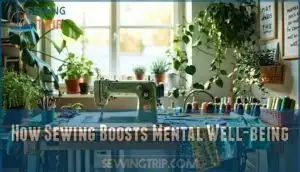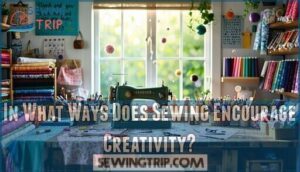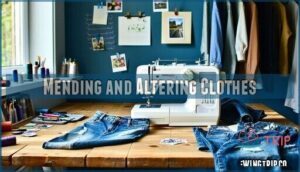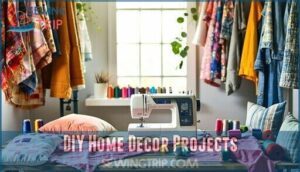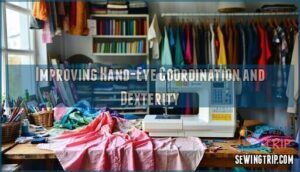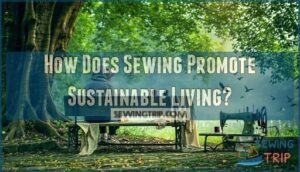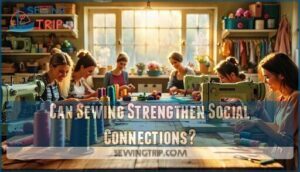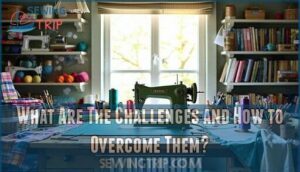This site is supported by our readers. We may earn a commission, at no cost to you, if you purchase through links.
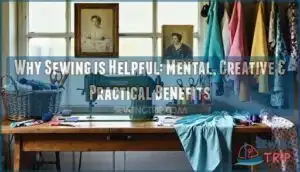
Sewing isn’t just about saving clothes or making new ones. It’s about breaking free from the tyranny of mass production, where everything fits "most people" and nothing fits you quite right. When you thread a needle and make that first stitch, you’re declaring independence from a system that treats you like just another size on a chart.
The question isn’t whether sewing is helpful—it’s how many ways it transforms your relationship with everything you wear and create.
Table Of Contents
- Key Takeaways
- Why is Sewing Helpful for You?
- How Sewing Boosts Mental Well-being
- In What Ways Does Sewing Encourage Creativity?
- What Practical Skills Can You Gain From Sewing?
- How Does Sewing Promote Sustainable Living?
- Can Sewing Strengthen Social Connections?
- What Are The Challenges and How to Overcome Them?
- Frequently Asked Questions (FAQs)
- Conclusion
Key Takeaways
- Sewing gives you real control over your wardrobe by letting you repair, alter, and create clothes that actually fit your body instead of settling for mass-produced sizes that never quite work.
- The repetitive motions of stitching provide genuine stress relief and mental health benefits—research shows it lowers heart rate, reduces cortisol, and improves cognitive function while keeping your hands and mind focused.
- Learning to sew builds practical skills that save serious money (up to 60% on clothing costs) while reducing textile waste, letting you upcycle and repair instead of constantly buying and throwing away.
- Sewing connects you to communities of makers who share techniques and support, with 91% of active sewists reporting stronger feelings of belonging and significantly lower loneliness scores.
Why is Sewing Helpful for You?
Sewing offers something different to everyone who picks up a needle and thread.
Your reasons for learning might be deeply personal, wildly practical, or somewhere in between.
Let’s explore what draws people to this craft and what it might reveal for you.
Personal Perspectives on Sewing
Everyone who sews carries a different story about why they picked up that first needle—maybe it was a grandmother’s patient hands, a ripped favorite shirt that deserved rescue, or just the rebellious urge to make something the world had never seen before.
These Sewing Journeys shape how you connect fabric to mental health, creativity to confidence, and relaxation to personal growth. Sewing Diaries reveal common threads:
- Self Reflection through quiet, focused handwork
- Creative Outlets that break free from mass-produced sameness
- Reclaiming control over your wardrobe and style
- Building confidence with every finished seam
- Finding calm in the rhythm of needle and thread
Your path into sewing becomes part of who you are.
Common Motivations for Learning to Sew
Sewing isn’t something you just fall into. It usually starts with a problem—a favorite shirt that needs fixing, an idea you can’t shake, or frustration with what’s available in stores.
That first moment at the machine? It comes from somewhere real.
| Motivation | What It Offers | Why It Matters |
|---|---|---|
| Sewing Inspiration from worn-out favorites | Rescue and revival | You control what stays in your life |
| Creative Freedom to design | Unique style expression | Break free from cookie-cutter fashion |
| Personal Growth through making | Confidence and skill building | Every project proves what you can do |
| Relaxation in repetitive motion | Mental health support | Calm your mind while your hands work |
| Hobby Development over time | Mastery and community | Build something that lasts |
Whether you’re chasing creativity or just tired of bad hems, sewing meets you where you’re at.
Reflecting on Individual Experiences
Your own sewing story probably doesn’t look like anyone else’s—and that’s exactly what makes it worth paying attention to. Maybe you found Sewing as Therapy after a tough season, or you’re chasing Creative Freedom one fabric scrap at a time.
Each stitch becomes Self Expression, building Confidence through Accomplishment.
Your Sewing Journeys teach you things books can’t—Skill Building paired with Self Reflection unlocks Personal Growth and real Mental Health Benefits that reshape how you see yourself.
How Sewing Boosts Mental Well-being
Your mind needs a break, and sewing delivers it. When you thread a needle or guide fabric through your machine, you’re tapping into a powerful mental health tool backed by real science.
The act of stitching rewires your brain in surprising ways.
Stress Relief and Relaxation
When the rhythm of needlework takes over, something shifts—your shoulders drop, your breath steadies, and the static noise in your head starts to quiet down. That’s stress relief in action.
Sewing works as therapy because it demands just enough attention to pull you out of worry loops while keeping your hands busy. The repetitive motions trigger mental calm, turning crafting into one of the most effective relaxation techniques you can master.
It’s mindful sewing without the pressure—just you, fabric, and breathing room.
Mindfulness and Focus
Every stitch becomes an anchor—a single point where your mind can’t wander because your hands won’t let it. This is mindful stitching in essence—focused sewing that pulls you into a creative flow state where distractions fade.
Meditative embroidery and other calming crafts train your brain to stay present, turning mindfulness activities into powerful tools for mental wellbeing through sewing and genuine stress relief.
Reducing Anxiety and Improving Mood
Dopamine doesn’t ask permission—it floods your system the moment needle meets fabric, lifting worry like thread pulled free from a seam. This is anxiety relief in action—mindful stitching that delivers calming effects and genuine mood boosters through therapeutic effects of crafting.
It doesn’t get simpler than this:
- Your racing thoughts slow to match the rhythm of your stitches
- Cortisol drops while your hands create something real
- Each completed seam proves you can finish what you start
- Fabric transforms under your control when life feels chaotic
- Mental wellbeing through sewing becomes your rebellion against anxiety
That’s stress relief with proof you can hold.
Scientific Evidence for Mental Health Benefits
Your hands might’ve sensed this already, but now there’s data to back it up. When researchers followed 256 adults over time, they found something striking: people who crafted regularly experienced 45% less cognitive decline.
Each stitch you make appears to build neuroplasticity effects while strengthening cognitive function.
Mental wellness improves measurably: heart rates drop 11 beats per minute, cortisol levels fall, and dopamine floods your system. These therapeutic benefits deliver real mental health gains—emotional regulation, lifted self-esteem, and enhanced cognitive wellbeing that science confirms through benefits of crafting and therapeutic effects of crafting.
The practice of slow stitching promotes a mindful approach to sewing, which can lead to improved mental health outcomes.
In What Ways Does Sewing Encourage Creativity?
Sewing isn’t just about following instructions—it’s where you take control and make something entirely your own. Every stitch gives you the freedom to experiment, explore, and push creative boundaries.
Here’s what sewing does for your creative mind—and some of it might surprise you.
Experimentation With Patterns and Fabrics
Choosing your first fabric feels like opening a door to endless possibilities—will you reach for bold florals, classic stripes, or something wonderfully unexpected?
Sewing patterns become your blueprint for rebellion, letting you mix materials that shouldn’t work but somehow do. You’ll play with color theory, matching threads to fabric weight, and suddenly you’re not just following instructions—you’re designing garments that scream "I made this."
DIY fashion hands you complete creative control, and that’s where the magic happens.
Developing a Unique Personal Style
When you stop buying off the rack and start sewing your own wardrobe, you’re not just making clothes—you’re building an identity that can’t be mass-produced.
Your style development becomes a form of fashion expression that reflects who you actually are, not what trend forecasters decided months ago.
DIY fashion gives you creative freedom to craft tailored garments that fit your body and self-image perfectly, turning sustainable fashion into pure self-expression through every stitch.
Problem-Solving and Critical Thinking
Sewing throws you into puzzle after puzzle—pattern pieces that refuse to line up, seams that pucker, and fabric that behaves nothing like you expected—and every fix sharpens your brain’s ability to think on its feet.
Each problem analysis pushes your analytical skills further, forcing you to find creative solutions through logical reasoning.
This constant problem-solving builds self-discipline while delivering the kind of accomplishment that proves your critical thinking can overcome any challenge.
Bringing Creative Ideas to Life
Once you’ve solved the technical puzzles, the real thrill is watching your imagination take shape in your hands—turning a sketch in your head or a photo you love into something you can actually wear, use, or gift. That’s creative freedom at its best—the design process flows through fabric selection and sewing techniques into pure artistic expression.
DIY fashion projects let you break free from mass production, embracing sustainable fashion practices while the sewing community cheers every original creation you bring into the world.
What Practical Skills Can You Gain From Sewing?
Sewing isn’t just about making things look good—it’s about building real skills that put you in control.
You’ll master practical techniques that save money, solve everyday problems, and give you the confidence to create what you need.
Pick up needle and thread, and these skills are yours.
Mending and Altering Clothes
You don’t need to toss a garment just because it’s slightly too long, too loose, or has a small tear—simple sewing fixes can breathe new life into pieces you already love. Learning alteration techniques and clothing repair gives you power over your wardrobe. Hemming pants, taking in seams, and patching torn fabric are free repairs that save money and reduce waste.
These sustainable fashion practices put sewing for beginners within reach.
- Take control: Master fabric upcycling and garment refashion instead of buying replacements
- Break free: Stop depending on expensive tailors for basic alterations
- Own your style: Transform ill-fitting pieces into perfectly tailored garments through textile restoration
Creating Custom Clothing and Accessories
Beyond repairs and alterations, sewing unlocks the freedom to design one-of-a-kind pieces that no store could ever offer you. You’ll choose every fabric, stitch custom apparel from sewing patterns, and craft accessories that scream your personality.
Fashion design becomes yours to command when you make your own clothes. Textile selection lets you build a sustainable fashion wardrobe exactly how you want it—DIY clothing that fits perfectly and reflects who you really are.
DIY Home Decor Projects
Your sewing machine isn’t just for wearables—pillows, curtains, table runners, and throw blankets are all fair game for your next creative project.
Fabric selection transforms ordinary rooms into tailored spaces that match your vision. Whether you’re tackling upholstery projects or stitching custom curtains, home textiles become your canvas for decorative sewing that brings stress relief and mindfulness into every stitch.
Improving Hand-Eye Coordination and Dexterity
Threading a needle and guiding fabric through a machine demands the kind of precision that quietly rewires your brain for better coordination. Every seam you stitch sharpens fine motor skills and hand movement while your eye focus tracks each stitch formation.
This dexterity training doubles as coordination exercises that strengthen neural pathways—sewing becomes both creative expression and practical therapy. Textile arts and self-expression merge into one powerful skill-building practice.
How Does Sewing Promote Sustainable Living?
Sewing isn’t just about creating beautiful things—it’s also a powerful tool for taking control of your environmental impact. When you pick up a needle and thread, you’re making a choice that goes against wasteful consumer habits and breaks free from the cycle of disposable fashion.
Here’s how sewing puts you in control—helping you cut waste, stretch your budget, and wear your values on your sleeve.
Reducing Textile Waste
Every year, the global fashion system churns out 92 million tonnes of textile waste—a mountain you can help shrink. When you sew at home, you take control of fabric use and turn scraps into something new instead of trash.
Sewing cuts waste in three key ways:
- Repair instead of replace: Fixing a torn seam or hem keeps clothing out of landfills and displaces new purchases 82% of the time
- Upcycle with purpose: Transform unwanted garments into fresh pieces through creative reconstruction and fabric recycling
- Optimize every inch: Smart pattern placement achieves up to 87% fabric utilization, leaving minimal waste behind
The circular economy thrives when you embrace sustainable fashion practices like mending and upcycling. Your needle becomes a tool for eco-friendly rebellion against textile waste. By adopting a slow fashion approach, you can markedly reduce your environmental footprint.
Saving Money With DIY Projects
A basic sewing machine and fabric scraps can slash your clothing budget by 60% or more, putting serious cash back in your pocket. Budget Sewing and Thrifty Crafting transform home alterations into a rebellion against overpriced retail. Make your own clothes using upcycling techniques for true self-sufficiency in Frugal Fashion.
| DIY Project | Store Cost | DIY Cost |
|---|---|---|
| Simple dress | $45–$80 | $12–$25 |
| Throw pillows | $30–$50 | $8–$15 |
| Curtains (pair) | $60–$120 | $20–$40 |
| Tote bag | $25–$45 | $5–$12 |
| Hem pants | $15–$25 | $0–$2 |
DIY Decor and sustainability go hand in hand when sewing reclaims control from fast fashion.
Ethical Fashion Choices
When you stitch your own wardrobe, you’re casting a vote against exploitative labor practices and environmental destruction with every seam. Slow Fashion and Conscious Consumption put power back in your hands, letting you choose Sustainable Fabrics and Fair Labor over the Fashion Industry’s brutal supply chains.
- Select organic cotton, linen, or deadstock textiles that honor the planet
- Break free from fast fashion’s cycle of waste through Upcycling Clothing
- Support Fashion Industry Ethics by controlling every step of production yourself
- Build Community with makers who value Sustainability and SelfExpression
- Transform sewing into an act of rebellion against corporate greed
Extending The Lifespan of Garments
Mastering repair transforms every garment into a long-term investment instead of a disposable commodity. You’ll replace zippers, reinforce seams, and patch holes—taking control of Clothing Maintenance rather than tossing pieces away.
Garment Repair skills give you freedom from textile production cycles, letting you preserve quality Fabric through Textile Restoration. Each stitch extends lifespan, slashes waste, and reinforces your commitment to Sustainable Fashion without relying on free alterations from retailers.
Can Sewing Strengthen Social Connections?
Sewing isn’t just something you do alone in a quiet room. It creates opportunities to communities where people share skills, swap fabric stories, and cheer each other on.
Let’s look at the ways sewing builds community and connection.
Joining Sewing Groups and Communities
Finding your people transforms everything. Joining sewing communities creates opportunities you didn’t know existed—whether through local guilds or online forums buzzing with member engagement. Here’s what community building through crafts delivers:
- 79% of sewists gather monthly or more, creating consistent social connection
- 91% report stronger belonging to their communities
- 76% master three new techniques within their first year through group projects
- 57% participate in fabric swaps and skill-sharing activities
- Social benefits of sewing include 23% lower loneliness scores among active members
These spaces fuel both your craft and your confidence.
Participating in Workshops and Events
Workshops harness community energy, channeling it into immersive learning experiences that leave a lasting impression long after the final stitch. Whether you’re engaged in workshop projects or sewing classes, event planning fosters a sense of camaraderie among sewists, offering intense skill-sharing sessions that boost confidence.
| Workshop Type | Community Benefit | Skill Focus |
|---|---|---|
| Beginner Classes | Newcomer welcome | Foundation techniques |
| Themed Events | Creative inspiration | Specialized projects |
| Skill Exchanges | Peer mentorship | Sophisticated methods |
This community-driven approach to crafts elevates sewing from a mere hobby to a transformative experience. It’s not just about learning; it’s about embracing your creative potential alongside like-minded individuals who share your passion.
Combating Loneliness and Building Friendships
Beyond the buzz of workshops and classes, something quieter happens when you pick up needle and thread—you stop feeling so alone. Sewing as a hobby builds friendship circles naturally, where shared projects spark real conversations.
These support networks boost social wellbeing through craft therapy—connecting you to community building and group activities that transform social connections into lasting bonds.
What Are The Challenges and How to Overcome Them?
Sewing isn’t always smooth sailing, and that’s completely normal. You’ll face real obstacles like time constraints, supply costs, and motivation dips along the way.
Let’s break down how to push through each one and keep your momentum alive.
Time Commitment and Learning Curve
Let’s be honest—you don’t have endless hours to dedicate to perfecting your stitches, and that’s perfectly fine. Sewing as a hobby demands self-discipline, but you control the learning pace.
Start with these strategies:
- Set realistic sewing schedules that fit your life
- Practice one skill at a time instead of rushing everything
- Track your progress to stay motivated and build confidence
Time management beats excellence every time.
Cost of Supplies and Tools
Sewing supplies don’t have to drain your wallet if you know where to look and what you actually need. Start with a basic sewing kit—thread, needles, pins, and scissors—then add tools as projects demand them.
Hunt fabric at thrift stores or clearance bins instead of premium textile shops. Your equipment investment grows with your skills, not before.
Smart crafting means prioritizing essentials over fancy notions that collect dust.
Staying Motivated and Disciplined
Your motivation muscles need regular workouts just like the skills themselves—discipline becomes your silent partner when inspiration decides to ghost you. Self-discipline grows through time management that respects your creative energy, not some drill sergeant schedule.
Here’s what keeps you stitching:
- Set bite-sized goals that build momentum instead of crushing you with impossible standards
- Schedule short sessions that fit your real life—twenty focused minutes beats vague someday plans
- Track projects visually so you see progress, not just the mountain ahead
- Reward finished work to wire your brain for self-improvement that sticks
Personal development through sewing means showing up messy and imperfect, weaving consistency into your craft one seam at a time.
Tips for Beginners to Get Started
Pick up your first project like you’re choosing a favorite snack—simple, satisfying, and guaranteed not to stress you out. Start with Beginner Projects that master Sewing Basics without intimidation.
These mindfulness activities reveal Benefits of Sewing as Creative Outlets for Women seeking control over their craft.
| Essential Element | Why It Matters |
|---|---|
| Sewing Tools | Quality scissors and needles make learning easier |
| Fabric Selection | Cotton works best for first attempts |
| Sewing Kit essentials | Thread, pins, seam ripper save frustration |
| Pattern Making intro | Pre-made patterns teach construction logic |
Frequently Asked Questions (FAQs)
How does sewing contribute to personal mindfulness and stress relief?
Like thread guiding needle through fabric, mindfulness pulls your scattered thoughts into single-point focus.
Sewing meditation calms racing minds through repetitive motions—each stitch becomes an anchor.
This mindful stitching delivers genuine stress reduction while boosting cognitive wellbeing and self-esteem naturally.
What are the psychological benefits associated with the creative process in sewing?
Creative Expression through sewing delivers real mental health wins. You’ll find stress relief and mindfulness as your hands work, plus stronger cognitive wellbeing.
This therapeutic outlet sharpens cognitive function, boosts self-esteem, and creates emotional balance that lasts.
Does sewing improve your physical health and posture?
Research shows sewing activities can lower heart rate by eleven beats per minute. The rhythmic motion promotes Muscle Relaxation and Stress Relief, supporting Mental Health through focused Creativity and SelfSufficiency rather than serving as Physical Therapy.
While sewing strengthens Hand Strength and improves Eye Coordination, it won’t fix poor Posture Correction on its own.
How does sewing benefit older adults specifically?
Older adults thrive with sewing as a retirement hobby that sharpens cognitive function and combats isolation. This creative hobby doubles as sewing therapy, delivering elderly benefits through improved hand-eye coordination, enhanced self-esteem, and aging wellness.
Senior crafts foster self-sufficiency while building meaningful social connections.
What role does sewing play in childhood development?
Think of sewing as planting seeds in young minds. It strengthens Child Development by building Motor Control, Cognitive Skills, and creativity.
It also teaches self-discipline, boosts self-esteem, and nurtures Emotional Intelligence through focused, hands-on Social Learning.
Can sewing help with trauma recovery or PTSD?
Many therapists use sewing for Trauma Therapy and PTSD Relief because Mindful Stitching calms your nervous system. The repetitive motion reduces stress, while Creative Expression fosters Emotional Healing.
This approach builds selfesteem and social wellbeing through creative selfimprovement.
How does sewing compare to other crafts?
All crafts offer therapeutic benefits, but sewing stands out for its unique blend of creativity and practicality. Unlike knitting or quilting, sewing lets you alter, repair, and create wearable art instantly.
This hands-on craft delivers immediate results while building skills you’ll use for life.
Conclusion
Take Maria, a nurse who learned to sew after losing her favorite jacket in a move. She started by patching scrubs, then graduated to making her own clothes. Now she designs pieces that actually fit her 12-hour shifts—pockets where she needs them, fabric that breathes.
When people ask, "Do you find sewing helpful? Why?" she doesn’t mention saving money or being creative. She talks about reclaiming agency. Every stitch is a vote against settling for what corporations think she needs.
Sewing isn’t about saving money or being creative—it’s about reclaiming agency, one stitch at a time, refusing to settle for what corporations decide you need
That’s the real power—you stop being a passive consumer and become the architect of your own wardrobe, your own comfort, your own rules.
- https://mimihali.com/blogs/news/the-mental-health-benefits-of-hand-sewing-how-mindful-stitching-supports-calm-focus-and-well-being
- https://www.womenschoiceaward.com/Health_and_Wellness_Benefits_of_Sewing/
- https://wunderlabel.com/blog/p/health-benefits-sewing/
- https://www.moodfabrics.com/blog/the-healthy-benefits-of-sewing/
- https://pubmed.ncbi.nlm.nih.gov/39956657/

